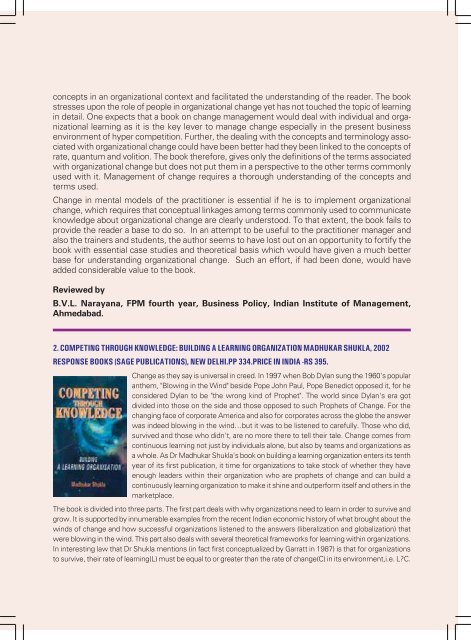NHRD Journal - National HRD Network
NHRD Journal - National HRD Network
NHRD Journal - National HRD Network
Create successful ePaper yourself
Turn your PDF publications into a flip-book with our unique Google optimized e-Paper software.
concepts in an organizational context and facilitated the understanding of the reader. The book<br />
stresses upon the role of people in organizational change yet has not touched the topic of learning<br />
in detail. One expects that a book on change management would deal with individual and organizational<br />
learning as it is the key lever to manage change especially in the present business<br />
environment of hyper competition. Further, the dealing with the concepts and terminology associated<br />
with organizational change could have been better had they been linked to the concepts of<br />
rate, quantum and volition. The book therefore, gives only the definitions of the terms associated<br />
with organizational change but does not put them in a perspective to the other terms commonly<br />
used with it. Management of change requires a thorough understanding of the concepts and<br />
terms used.<br />
Change in mental models of the practitioner is essential if he is to implement organizational<br />
change, which requires that conceptual linkages among terms commonly used to communicate<br />
knowledge about organizational change are clearly understood. To that extent, the book fails to<br />
provide the reader a base to do so. In an attempt to be useful to the practitioner manager and<br />
also the trainers and students, the author seems to have lost out on an opportunity to fortify the<br />
book with essential case studies and theoretical basis which would have given a much better<br />
base for understanding organizational change. Such an effort, if had been done, would have<br />
added considerable value to the book.<br />
Reviewed by<br />
B.V.L. Narayana, FPM fourth year, Business Policy, Indian Institute of Management,<br />
Ahmedabad.<br />
2. COMPETING THROUGH KNOWLEDGE: BUILDING A LEARNING ORGANIZATION MADHUKAR SHUKLA, 2002<br />
RESPONSE BOOKS (SAGE PUBLICATIONS), NEW DELHI.PP 334.PRICE IN INDIA -RS 395.<br />
Change as they say is universal in creed. In 1997 when Bob Dylan sung the 1960's popular<br />
anthem, "Blowing in the Wind" beside Pope John Paul, Pope Benedict opposed it, for he<br />
considered Dylan to be "the wrong kind of Prophet". The world since Dylan's era got<br />
divided into those on the side and those opposed to such Prophets of Change. For the<br />
changing face of corporate America and also for corporates across the globe the answer<br />
was indeed blowing in the wind…but it was to be listened to carefully. Those who did,<br />
survived and those who didn't, are no more there to tell their tale. Change comes from<br />
continuous learning not just by individuals alone, but also by teams and organizations as<br />
a whole. As Dr Madhukar Shukla's book on building a learning organization enters its tenth<br />
year of its first publication, it time for organizations to take stock of whether they have<br />
enough leaders within their organization who are prophets of change and can build a<br />
continuously learning organization to make it shine and outperform itself and others in the<br />
marketplace.<br />
The book is divided into three parts. The first part deals with why organizations need to learn in order to survive and<br />
grow. It is supported by innumerable examples from the recent Indian economic history of what brought about the<br />
winds of change and how successful organizations listened to the answers (liberalization and globalization) that<br />
were blowing in the wind. This part also deals with several theoretical frameworks for learning within organizations.<br />
In interesting law that Dr Shukla mentions (in fact first conceptualized by Garratt in 1987) is that for organizations<br />
to survive, their rate of learning(L) must be equal to or greater than the rate of change(C) in its environment,i.e. L?C.<br />
November 2007 <strong>N<strong>HRD</strong></strong> <strong>Journal</strong> 129
















